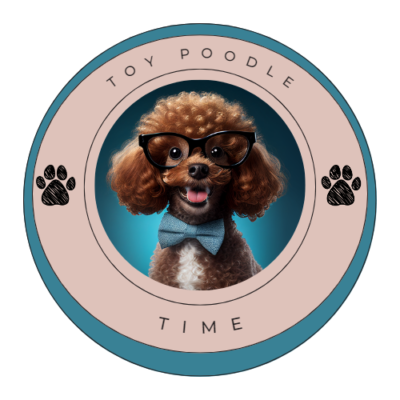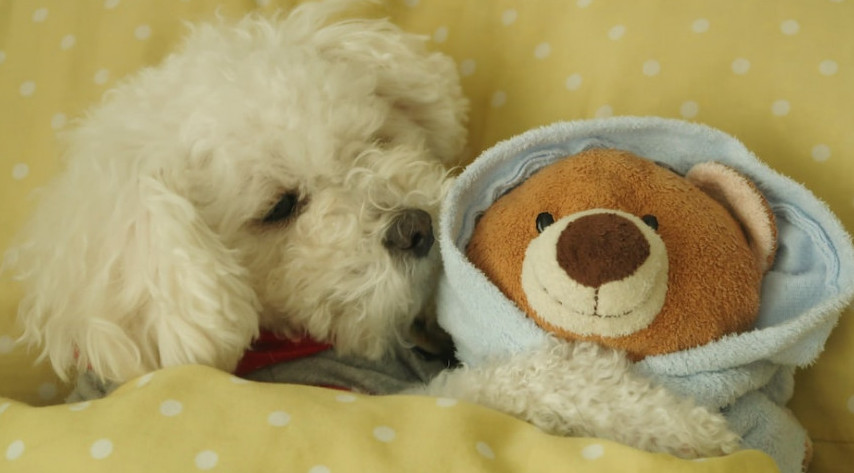
What’s the #1 thing dogs spend most of their time doing? No, it’s not licking themselves (although that is probably a close second), it’s sleeping of course! Depending on their age, dogs spend between 12-18 hours a day sleeping, that’s a lot of time! With all that sleeping, it’s important to provide them with a nice comfortable place they can call their own. Come on, you wouldn’t want to spend all that time sleeping on the floor, would you? Well, neither does your furry friend. Luckily, there are a ton of dog bed choices on the market today, and plenty of those choices are dog beds for small dogs.
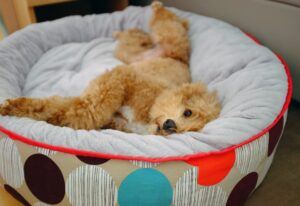 But Does My Dog Really Need a Bed?
But Does My Dog Really Need a Bed?
Yes! Even if your beloved pooch typically sleeps in your bed, they still need their own bed. Dog beds provide a comfortable space that your little companion can call their own. A safe, secure, familiar area that they can retreat to not only to sleep, but also chill out in if they are feeling anxious. Just like humans, your dog needs a stress-free oasis for alone time. This is especially important for small dogs who overall tend to be more anxious and skittish compared to larger dogs. A comfortable bed helps your pup sleep better which improves their mind and body. It’s true, a good snooze actually helps dogs learn better. Many small dogs, especially Toy Poodles, are prone to elbow and knee luxation, and dog beds for small dogs can help alleviate joint and muscle pain. If those aren’t enough good reasons to give your pup with a bed, here’s one more. Providing your dog a bed that she loves may decrease the time she spends on the furniture, which means less pet hair everywhere, which means less time spent cleaning pet hair everywhere. Okay, so you know your dog needs a bed, how do you choose the right one?
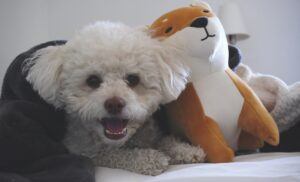 Choosing the Right Dog Beds for Small Dogs
Choosing the Right Dog Beds for Small Dogs
There is no “one size fits all” when it comes to dog beds. Just like there are all different sized dogs with different needs, there are dog beds designed to match your pup. Focusing on your dog’s uniqueness will help narrow down your search for the ultimate bed. Choosing the right bed is essential if you want to keep your companion as comfortable as possible, here are a few things to consider when choosing your dog’s bed.
Age – If you have a dog that is still growing, you might want to go a little bigger to account for size increase. Puppies chew on everything, so a more durable material is best. They are also still potty training, so look for waterproof material. Older dogs may have some incontinence too, so again, waterproof is best. Older dogs tend to suffer from achy joints and muscles, so a comfortable yet firmer bed with may be the best choice.
Size – Measure your pup nose to base of tail, then add several inches to find a bed length that’s suitable for your small dog. These added inches will give him enough room to stretch, but not so much room that he doesn’t feel secure. It will also give you enough space to add a blanket or toy without crowding out your pup. If you are sizing up because you have a puppy, you can add a blanket to his bed for a cozier fit too.
Habits – Does your dog tend to run hot? Maybe not such a problem with our small guys, but if they do, choose a bed that allows for more airflow. A fluffy, faux fur option would be better for pups that get cold easily. Does your dog drag every gross, dirty thing he can find outdoors into his bed? Then an easy to clean bed, preferably with a removable cover, may be the best choice for you. Is it your dog’s mission in life to chew and shred everything? Well, there’s a bed for that too.
Sleep Style – Check out how your dog sleeps. Is he a superman sleeper? How about curled up in a tight little ball? You live with a burrower? Does your dog need to be leaning against the furniture to get a good snooze in? Or a side sleeper, legs straight out like she’s suddenly got giraffe legs? Knowing your dog’s sleeping style goes a long way in finding them just the right fit.
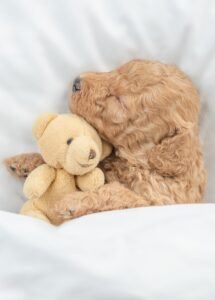 What to Look for in a Dog Bed
What to Look for in a Dog Bed
There are some essential things to look for when buying dog beds for small dogs.
Support – Most dog beds are made with a polyester filling to give it a nice fluffy feel, or a memory foam for a firmer, supportive feel.
Burrowers like my mom’s younger Chihuahua, Cassie, love the fluffy, squishy beds that kind of envelop them in soft warm fur. That actually sounds pretty darn comfy!
On the other hand, seniors would benefit more from a memory foam bed that conforms to your dog’s body, providing relief to achy joints and bony prominences. As your pet ages, they lose muscle mass, so bony areas are not as protected anymore. Seniors also experience achier spine and joints than younger pets. A foam bed is soft, yet firm enough to offer support to our senior dogs. Many small dog breeds are prone to bone and spine disorders such as luxating patellas and elbows, or intervertebral disc disease (IVDD). This is the case with my Toy, Fred. He is not only a senior, but also has luxating patellas. His memory foam bed is firm enough that he can get in and out of bed easily, but soft enough to support his achy joints and bony areas. Look for a bed that has orthopedic in the description when searching for a foam bed and when you press down on the foam, then release, it rebounds quickly.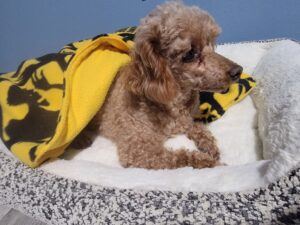
The bolsters surrounding bed base should also be structured yet plush enough to act as neck support, like a pillow, for dogs that like to stretch out. Bolsters are helpful for dogs that normally lean against furniture while sleeping as well. Also, look for a low-profile area on the front bolster so your pet can step in and out of their bed easily.
Comfort – Your dog’s bed should promote relaxation and offer a sense of security, both of which encourage a cozy restful sleep. Just like us, if your dog can’t find a comfortable position in bed, he’s not going wake up feeling his best.
Durability – Sometimes dog beds go through a lot. You’ll want a sturdy durable base that can withstand nesting, scratching, digging, dragging, maybe even chewing, or peeing.
Ingesting the fibers and fill from a dog bed is very dangerous and can lead to severe intestinal blockages, so look for durable materials if your dog is a chewer or digger. Nylon and canvas materials are made to stand up to these intense behaviors. If you live with a dog that “can’t have nice things” then look for a dog bed that is chew proof. They are typically made with no exposed seams or zippers, and heavy-duty nylon. Some are even fully refundable.
Waterproof dog beds are great for puppies still training or senior with incontinence issues. These beds usually have a waterproof cover protecting the inner core. If your dog has an accident, simply take the outer cover off and wash. Some waterproof linings can be loud and crinkly, which tends to scare small dogs, so make sure you check the bed or reviews about this issue.
Washable – Having the ability to wash your dog’s bed is super important. Think about how uncomfortable you’d be if you had to sleep on the same unwashed sheets every day. Ok, maybe not the best example since dogs love to roll in the smelliest things they can find, but there are other reasons to wash your dog’s bed besides smell. Dirty beds are a perfect breeding ground for bacteria that could make your dog sick. Crumbs left over from a snack in bed can attract bugs. A wet bed resulting from urine can burn your pet’s skin if they lay in it for a prolonged period of time. Fleas, ticks, spiders, and other creepy crawlies can hitch a ride on your pup and make a dirty dog bed their home. Pet hair and dander can build up on an unwashed bed, weaking havoc on your allergies. Lastly, while the smell might not bother your pet, it will probably bother you, and will most certainly bother guests.
Some beds you can toss right in the washing machine and dryer but may lose their shape and integrity over time. A better option is a removable cover that can be machine washed. Look for a bed that comes with an additional cover so you can swap out while the other is in the laundry.
Style – Luckily, there are so many styles of dog beds for small dogs that you’re bound to find the perfect fit. Round beds, or donuts, work best for nesters and dogs that curl up into tight little balls. Nesters also like the tented dog beds for added privacy and security. Rectangular and pillow styles allow your pup to fully sprawl out. While others may enjoy a low-profile cot to keep cool if they tend to run hot or for hot summer months.
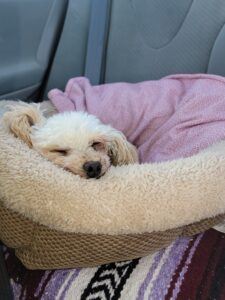 When to Get a New Bed
When to Get a New Bed
A well-made dog bed can last for several years but will eventually need to be replaced. Tears and holes in your dog’s bed can expose stuffing and other choking hazards to your dog, and beds should be replaced immediately. If your dog has recently been treated for parasites, like worms or ticks, or an extended illness, replace their bed. Stubborn odors that linger even after washing is a sign your dog needs a new bed. If the support just isn’t there anymore, such as sagging bolsters or base, it’s time for a new bed. It might not be the bed itself, but your dog. A dog’s needs change over time, and so should his bed. That super fluffy bed may have been great as a puppy, but as a senior your dog may find it too difficult to get in and out of.
 Should Your Dog Have 2 Beds?
Should Your Dog Have 2 Beds?
Your dog may benefit from having more than one bed. An additional bed for travel, or crate time, one that already smells like home, allows you to keep your pet comfortable in unfamiliar surroundings. Think about a second bed for the time of year as well. One bed for winter, and another for summer, keep it the ideal temp year-round for snoozing.
My Dog Hates Their Bed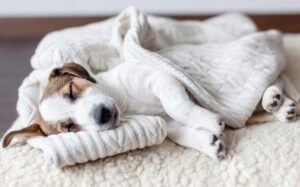
Ok, so clearly this little guy doesn’t, but what if your dog hates their bed? Well, there are a few things you can try before giving up. Place your dog’s bed in a quiet area away from drafts, maybe on the floor beside your bed. You may have to try several locations before your pup picks his favorite. Put a t-shirt with your smell on it in her bed, this helps make your pup feel more comfortable and secure. Offer treats or praise when your dog checks out their new bed. Be patient, it may take several days before your pup feels comfortable enough to call this her new spot.
Conclusion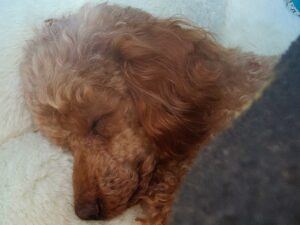
Dogs spend the majority of their time asleep, so a comfortable place to do their snoozing is a must. Dog beds for small dogs offer a comfortable, safe, familiar area they can call their own. Dog beds provide a place where your pup can relax and unwind. This is especially helpful for small dogs who tend to be a little more skittish and anxious compared to larger dogs. There are so many kinds of dog beds that it can be a little overwhelming, but once you know a few things about your dog, and what to look for in a dog bed, you’ll be choosing the perfect bed in no time. And if your dog could talk, they’d be saying THANK YOU!
